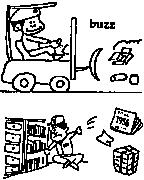|
|
Visual Management (Manufacturing Industries)
Visual Management (Manufacturing Industries)
|
Visual Management is a very effective operations management system. Visual Management
sets up the environment (office, factory, service center, distribution warehouse,
etc.) into an environment where man, machine, material, methods and environment
are harmoniously organized. Visual Management compliments many other total quality
management methods because the workflow is optimized according to the least resistance
for people doing work. Since people will always find the easiest path of work, Visual
Management is the workflow method of choice by employees.
|
Advantages
- A Visual Management
- No capital cost involved
- Homely working environment
- Safer working environment
- Saves work place
- Easy to see processes
- Satisfaction notes from employees
Your Problem
In most organizations, people find it hard to work together because they are all
entrenched in a circle that depends on the process before or the process after their
own. Nobody comes to work thinking that "Today I want to make some rejects or some
nonconformance". Even when people want to work smoothly they are restrained by the
system. Since the system evolved over a long period of time, under different managers,
engineers or supervisors, it is bound to be inefficient and cannot be handled by
any one person or department. The result is: people are demotivated in a system
that prevents change.
Our Solution
If management does not provide a clear work method for all tasks, the employee will
find an alternative solution. Therefore, it is paramount to provide a working environment
(operating procedure, service delivery, etc.) that allows the easiest work execution.
Anything else must be more difficult. Then, and only then, will the employee stay
within the stipulated working environment. Belmah Strategies can provide this work
environment through our Visual Management consisting of the following steps.
|
|
|
1. 5S Housekeeping
 Often the first step towards Visual Management is the conversion: workplace like
a home. When management converts the workplace like a home the immediate
result is: employee willingness for further improvement. This happens because,
it is comfortable to do work. 5S Housekeeping is based on the Japanese housekeeping
practice. 5S is necessary to ensure a clean and orderly working environment with
a highly visible management. With 5S, you can convert an untidy work space into
an efficient work place. 5S stands for:
Often the first step towards Visual Management is the conversion: workplace like
a home. When management converts the workplace like a home the immediate
result is: employee willingness for further improvement. This happens because,
it is comfortable to do work. 5S Housekeeping is based on the Japanese housekeeping
practice. 5S is necessary to ensure a clean and orderly working environment with
a highly visible management. With 5S, you can convert an untidy work space into
an efficient work place. 5S stands for:
|
Japanese
|
English
|
Explanation
|
|
Seiri
|
Sort
|
The things you need and the things you don't
|
|
Seiton
|
Arrange
|
Arrange the things you need in an orderly way
|
|
Seisho
|
Clean
|
Clean what you need and ensure they are in good working order
|
|
Seiketsu
|
Systematic
|
Organize them so you can take or replace easily without having to move other things
|
|
Shitsuke
|
Discipline
|
Maintain the above steps in keeping your workplace neat, clean and tidy
|
|
|
|
|
2. Product Flow Line
Once there is a clean environment, the next step is to improve the product flow
line. We make it easy to work. Less carrying of things, less moving around, less
steps and a very ergonomic flow line. For managers, the line is so easy to see.
There is no need for lengthy reports and long meetings. Product flow is visual and
process constraints are visual and action can be taken quickly. Often there is a
significant freeing up of space.
3. Staging Elimination
When the product flow line is achieved, staging is almost automatically eliminated!
Hard to believe, but true. When staging is eliminated cycle time is reduced. Batch
flow is also more sequential. Batch traceability is also obvious.
4. Process Invariance
When staging is eliminated (or reduced) processes can be made more consistent so
there is less batch to batch variation. Consequently, product quality becomes more
consistent and there is reduced waste.
5. Equipment Maintenance
At this stage, the equipment maintenance can be advanced to preventive maintenance.
Tool change and refurbishment can be monitored effectively and forward preparedness
is possible.
6. Materials Control
Until in-house processes are stabilised, it is sometimes very difficult to see variations
in incoming quality except at relying solely on incoming quality assurance sampling.
7. Store Organization
Stores are usually kept out of bounds for most people. Consequently, store management
is left poorly managed. With Visual Management, material can be organized systematically.
Shelf life can be monitored efficiently. Material can be classified and grouped
clearly so that traceability is improved. |
|









